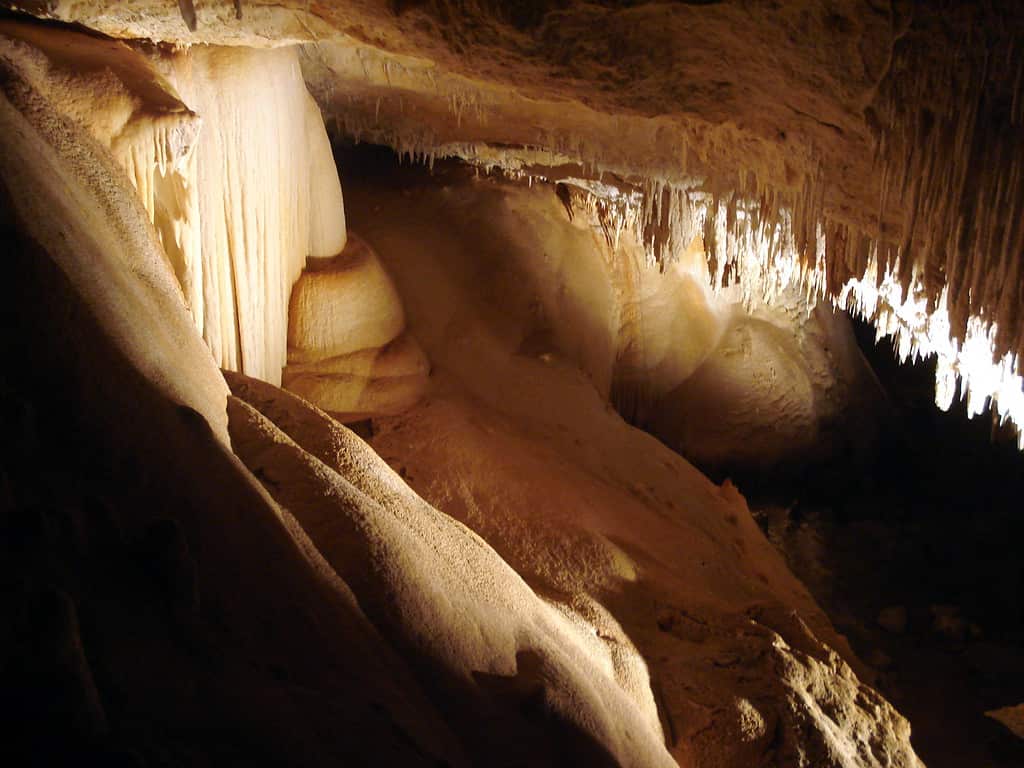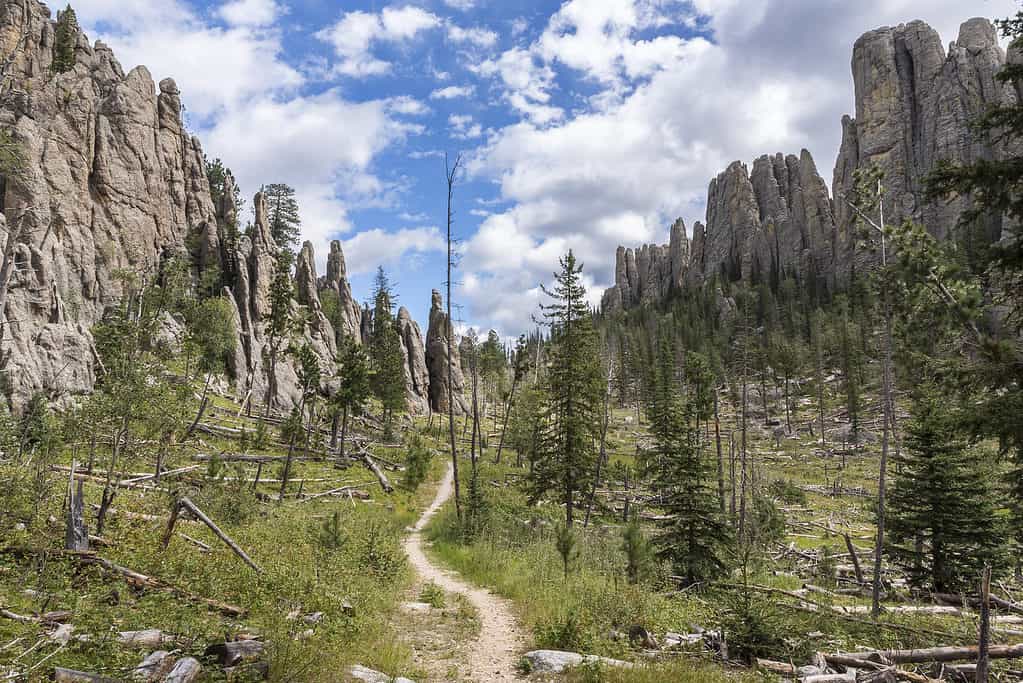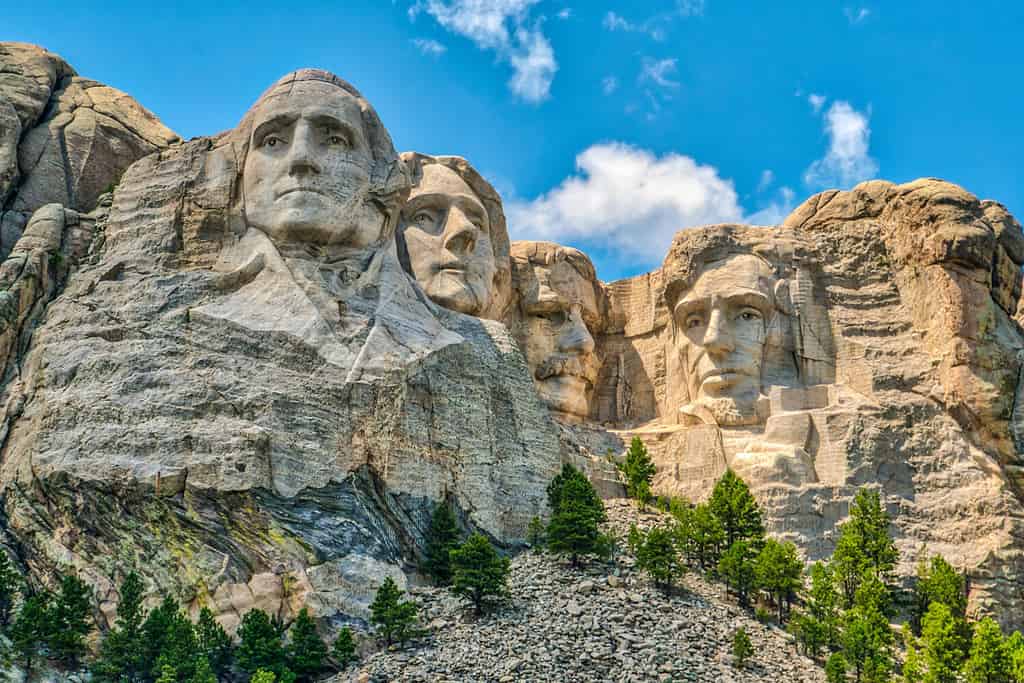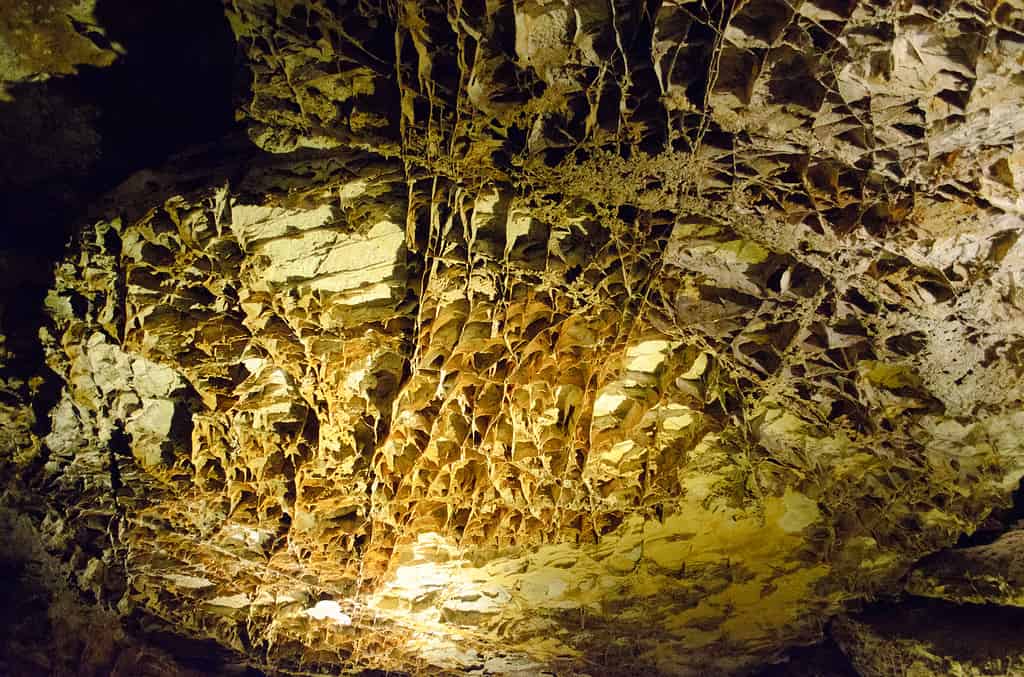When you think of South Dakota, you might think of iconic views like Mount Rushmore or Crazy Horse. Maybe herds of buffalo or the far-reaching prairies. Beneath all that, though, South Dakota hides some of the nation’s most magnificent cave systems. Many attribute the state’s cave-rich underbelly to the Paha Sapa Limestone formation, formed some 340 million years ago at the bottom of the Inland Sea. “Paha Sapa” comes from the Lakota tribes and roughly translates to “the hills that are black” — giving the Black Hills their name. Other minerals in the ground besides limestone also helped form amazing natural structures over the millennia for visitors to enjoy. So let’s strap on our headlamps and take a look at the top six best caves!

Note: Caves can be dangerous to explore on your own. Make sure you are equipped with proper shoes, layers, and light. Stay on marked paths or with a guide at all times. Also, carefully plan your packing if you plan to visit more than one cave during your trip. Most sites ask that you not wear clothing previously worn in a different cave system to limit the spread of disease among bat colonies.
Jewel Cave National Monument

Stalactites are just one example of the unique formations within Jewel Cave.
©Abir Anwar / CC BY 2.0 – License
Named for the crystalline structures in its walls, Jewel Cave is the third-longest cave in the world! (Only Mammoth Cave in Kentucky and Sistema Ox Bel Ha in Mexico are longer.) Cavers have mapped over 215 miles of tunnel since the Jewel Cave’s discovery in 1900. With so much space, you just know there’s a lot to see here. For example, cavers have identified more than 200 types of minerals and rocks within the cave. Jewel Cave features formations in every room. Unfortunately for the two prospectors who first discovered the cave, gold isn’t one of the many minerals present.
The National Park Service oversees Jewel Cave National Monument, which is located within the southwest corner of the Black Hills National Forest in Custer. The NPS offers four different guided tours, ranging from adventurous to kid-friendly. Though you can explore the surface of the cave area on your own during daylight hours, all cave access requires a guide and advance reservations.
Wind Cave National Park

Strategic lighting helps highlight Wind Cave’s unique structures and formations.
©Murray Foubister / CC BY-SA 2.0 – License
The first cave named a national park anywhere in the world, Wind Cave is the densest cave system in the world. It features some of the most unique mineral structures around. Honeycomb-like patterns called boxwork cross the cave walls, formed as the rock around a mineralized fracture erodes away over millions of years. Fun fact, nearly 95% of discovered boxwork is located in Wind Cave. So to see this unique calcite formation, Wind Cave should be at the top of your list! Frostwork also makes an appearance in the caves, growing on top of the boxwork with its “needle-like” growths that mimic the appearance of frost.
Similar to Jewel Cave, the National Park Service maintains and operates Wind Cave. Tickets are available in advance, and visitors have six tours to choose from. The most adventurous involves shimmying through passages equipped with helmets, knee and elbow pads, and headlamps just like modern cave explorers. Other tours include a candlelight-only tour that evokes the earliest Wind Cave expeditions, as well as a tour to the natural entrance of the cave to learn about the origin of the cave’s name. Though it’s no secret — strong gusts of wind frequently rush in and out of these caves to balance the air pressure of the caves, causing a whistling sound at the cave’s natural entrance.
On the surface, Wind Cave National Park boasts nearly 30 thousand acres of preserved land. Some of the last remaining prairie land lies within the park’s boundaries — the National Park Service calls it “the remnant island of intact prairie” — and plays host to bison, elk, prairie falcons, and many other native species.
Community Caves in Spearfish Canyon

Spearfish Falls is located in Spearfish Canyon, home to the Community Caves.
©Yanktonranger / CC BY-SA 4.0 – License
These caves offer an enticing destination for the hikers among us, one that’s mostly popular with locals instead of tourists. Glaciers formed Community Caves over 30 thousand years ago, leaving behind a variety of minerals that give the caves an orange-pink hue. The only way to see these caves, however, is by completing a short but strenuous hike. Just a half-mile long, the hike follows Spearfish Creek and gains 180 feet in elevation — that’s like climbing to the top of an 18-story building, but without the stairs to help you! Even avid hikers suggest using hiking sticks to assist your climb.
One of the best times to visit these caves is during the winter, which makes a difficult climb even harder with the addition of ice. The chance to see a frozen waterfall, though, makes the trail worth it to many. Even during the summer, the small waterfall cascading from the ledge above the caves makes for a breathtaking experience. The view of the rest of the canyon is another reward.
Wonderland Cave

Wonderland Cave is located on the northeastern edge of the Black Hills National Forest.
©iStock.com/John_Brueske
Wonderland Cave features an amazing variety of mineral and crystal formations, enough that whole chambers are named for their prominent feature. Called “the greatest show under the Earth,” Wonderland Cave began its first tours in 1930 and has been delighting visitors ever since! Tours start frequently and highlight the vast array of formations, ranging from boxwork and popcorn crystals to calcite lily pads and amazing helictites that seem to have formed in zero gravity.
Wonderland Cave stays a balmy 47 degrees year-round, so take a jacket as you explore one of the largest caves in the Black Hills.
Rushmore Cave

Rushmore Cave is the closest cave in proximity to Mount Rushmore.
©Exploring and Living/Shutterstock.com
If you’re looking for a single stop with something for the whole family, Rushmore Cave is it. This cave sits just miles from Mount Rushmore National Memorial and ranks as the ninth-longest cave in the state. Rushmore Cave features numerous rooms — named after their dominant feature, like the Big Room, Geode Room, or Fairyland — and offers guided walking tours that last up to an hour.
Rushmore Cave is also the original attraction at Rush Mountain Adventure Park, which now includes four additional attractions for visitors to enjoy.
The Black Hills Caverns

Boxwork is just one of the different formations to see in the Black Hills Caverns.
©Zack Frank/Shutterstock.com
The Black Hills Caverns offers a very different cave experience — even on its most basic walking tour, you’ll be led down tight, twisting passages rather than walking through spacious caverns. The owners of the Black Hills Caverns have kept the experience as close to its true nature as possible, though they have added stairs, handrails, and lighting to portions of the caves for safety reasons.
Unlike many other caves throughout the state, the Black Hills Caverns host relatively little life. A bat colony makes its home at the natural entrance, but that’s it aside from moss growing around electric lights and bacteria in the steam. What they lack in flora and fauna, though, the caverns make up for in geological formations. Visitors can see rare frost crystals, cave flowers, soda straw stalactites, boxwork, and much more.
Too Cool Not to Include: The Mammoth Site

Mammoth Cave features many full or nearly full fossilized mammoth skeletons.
©Jeff the quiet / CC0 – License
Not to be confused with Mammoth Cave in Kentucky, the Mammoth Site is a wonder located near Hot Springs, South Dakota. The Mammoth Site is not technically a cave, but it once was. It’s now completely covered by a building and interpretive center to protect the fossils. Regardless, this site holds a fascinating snapshot of the Ice Age, with the largest concentration of mammoth fossils ever found. Since the site was found in 1974, archeologists have unearthed over 60 fossilized mammoth skeletons, as well as nearly 90 other late Ice Age animals.
The Mammoth Site takes advantage of its discovery and has become the largest mammoth research facility in the world. In addition, it’s one of the top-rated fossil interpretive sites in North America. If you’re a paleontology buff, the Mammoth Site is a must-see!
Caves Closed For Good in South Dakota
With such geological variety beneath the ground, South Dakota is awash with cool caves. But a few will no longer be seen by modern eyes. Either through the decisions of its owners or because of years of mistreatment, some caves are now closed.
- Sitting Bull Crystal Caverns is known for its huge “dog tooth” calcite crystals and fantastic geode-like coloration. However, the family that has owned the cave since 1934 put Sitting Bull up for sale and closed the caverns to the public in 2015.
- Ludlow Cave was once the site of some of the country’s most intricate petroglyphs, depicting daily life and religious iconography of the area’s Native Americans. However, even the first group of non-native explorers — members of Lt. Col. Custer’s expedition — defaced the walls of this cave until very few of the ancient petroglyphs remained. The entrance to Ludlow Cave is now undisclosed.
Summary
South Dakota boasts an extensive variety of caves just under its surface, any of which would make an exciting adventure! Many locals, scientists, and Native American tribes in the area believe we have only scratched the surface, so to speak, and will continue to find new caves as we explore. Some even believe that all the caves connect to one another, thanks to the unique formation of the Paha Sapa Limestone formation. Limestone is just one of the many minerals in the soil and rocks that have changed and built up over the millennia to create breathtaking formations for visitors to enjoy in South Dakota’s caves. Happy exploring!
| Cave | Location | |
|---|---|---|
| 1. | Jewel Cave National Monument | Southwest corner of the Black Hills National Forest in Custer |
| 2. | Wind Cave National Park | South of Custer State Park |
| 3. | Community Caves in Spearfish Canyon | Spearfish Canyon |
| 4. | Wonderland Cave | Northeastern edge of Black Hills National Forest |
| 5. | Rushmore Cave | A few miles from Mount Rushmore National Memorial |
| 6. | The Black Hills Caverns | Eastern edge of Black Hills National Forest |
| 7. | The Mammoth Site | Near Hot Springs |
The photo featured at the top of this post is © Mahmoud Ghazal/Shutterstock.com
Thank you for reading! Have some feedback for us? Contact the AZ Animals editorial team.






